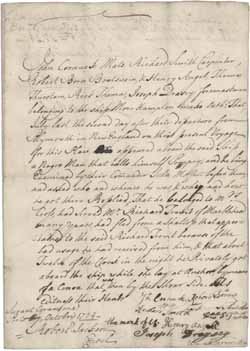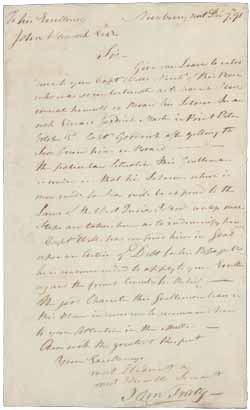The Struggle for Freedom
~Unknown Petitioners, June 1774
There were several ways that an enslaved person in colonial Massachusetts could gain freedom. Perhaps the most straightforward, and by far the most dangerous, method was simply to run away. Individual documents about freedom seekers are rare; newspaper advertisements for fugitive enslaved people remain our best source. However documents such as a deposition about an enslaved man named Pompey and a letter concerning an enslaved person who was a stowaway on the ship Susan clearly demonstrate that some chose this desperate course of action.
 Deposition of John Cornuck and others regarding Pompey (a freedom seeker), 7 October 1724
Deposition of John Cornuck and others regarding Pompey (a freedom seeker), 7 October 1724
 Letter from John Tracy to John Hancock, 7 December 1791
Letter from John Tracy to John Hancock, 7 December 1791
 Receipt from Henry Ward to Otis Baker for sale of Cato (an enslaved person), 6 December 1763
Receipt from Henry Ward to Otis Baker for sale of Cato (an enslaved person), 6 December 1763
Another path to freedom was that of manumission (the legal act of freeing an enslaved person), a tradition as old as the Roman Empire. Writs of manumission such as the statement on the second page of a receipt granting freedom to Cato were all that was required to free an enslaved person; however, for a short time after the passage of a 1703 colonial law, no enslaved person could be manumitted without posting a £50 bond with the municipal government (Greene, 1942; 138). This bond was intended to ensure that the newly free person could be provided with food and lodging, in case of unemployment or illness. While this particular law remained in effect for about a year, the maintenance and care of elderly, infirm, and incapacitated victims of enslavement remained a primary concern (principally for economic rather than humanitarian reasons) for colonial citizens. Enslaved people could also be manumitted by purchasing their own freedom. And while the exact process of purchasing freedom was seemingly not standardized, it was certainly possible as evidenced on the second page of a receipt for the sale of Corydon, who paid £75 for his freedom.
Another option enslaved people had to gain their own freedom was that of legal petition. In the early 1770s, groups of Massachusetts enslaved people and freemen petitioned the colonial government, claiming that freedom was a right belonging to all men and women. Examples of petitions include one from June 1773, another from 25 May 1774, a third dated June 1774, and a fourth example dated January 1777. Even though there was much public discussion of liberty and freedom in the years leading up to the Revolution, the Massachusetts colonial government had little authority to end, or even curtail, slavery or the trade of enslaved people because of instructions from Parliament to the royal governor, and none of the petitions succeeded.
 Petition for freedom to Massachusetts Governor Thomas Hutchinson, His Majesty's Council, and the House of Representatives, June 1773
Petition for freedom to Massachusetts Governor Thomas Hutchinson, His Majesty's Council, and the House of Representatives, June 1773
 Petition for freedom to Massachusetts Governor Thomas Gage, His Majesty's Council, and the House of Representatives, 25 May 1774
Petition for freedom to Massachusetts Governor Thomas Gage, His Majesty's Council, and the House of Representatives, 25 May 1774
 Petition for freedom to Massachusetts Governor Thomas Gage, His Majesty's Council, and the House of Representatives, June 1774
Petition for freedom to Massachusetts Governor Thomas Gage, His Majesty's Council, and the House of Representatives, June 1774
 Petition for freedom (manuscript copy) to the Massachusetts Council and the House of Representatives, [13] January 1777
Petition for freedom (manuscript copy) to the Massachusetts Council and the House of Representatives, [13] January 1777
Enslaved people also could sue for their own freedom, either on the basis of a contractual agreement with the enslaver or, much later, on the basis of a natural right to freedom. While the former method was successful for individuals as early as 1701--in the case of Adam (see the manuscript agreement between John Saffin and Adam and The Selling of Joseph by Samuel Sewall), the latter argument would eventually bring about a legal end to slavery in Massachusetts. It is interesting to note that although enslaved people were clearly considered property under colonial law, and there were many laws restricting their activity (curfews, anti-fornication laws, etc.) there were also some circumstances where enslaved people were treated as citizens by the legal system. When charged with a crime, they had many of the same rights as free white citizens (trial by jury for example, although it would invariably be an all-white jury), and a contract made with an enslaved person was just as binding as one made with a free person. John Adams remarked that he "never knew a Jury, by a Verdict to determine a Negro to be a slave -- They always found them free." While Adams often exaggerated to make a point, given this consistent pattern of juries finding in favor of enslaved people when they sued for their own freedom, it is not surprising that slavery was eventually abolished in Massachusetts by the judicial system rather than the legislature. (For more information, please see the next section of this website, "The Legal End of Slavery in Massachusetts.")
Featured Items
- Deposition of John Cornuck and others regarding Pompey (a runaway enslaved person), 7 October 1724
- Letter from John Tracy to John Hancock, 7 December 1791
- Receipt from Henry Ward to Otis Baker for sale of Cato (an enslaved person), 6 December 1763 [Note: Page 2 is a document giving Cato freedom signed by Otis Baker and witnessed by Jeremy Belknap, 4 June 1777.]
- Receipt from William Shackford to James Chesley for sale of Corradan (Corydon) (an enslaved person), 19 July 1756 [Note: Page 2 is a receipt of payment in exchange for freedom of Corydon signed by Otis Baker, 13 April 1778.]
- Indenture between Isaac Smith and Scipio Dalton (an enslaved person) regarding his freedom, 20 June 1779, with addendum, 20-24 December 1779
- Document signed by John Saffin regarding the emancipation of Adam (an enslaved person), 26 June 1694
- The Selling of Joseph by Samuel Sewall
- Samuel Sewall, portrait by Nathaniel Emmons

